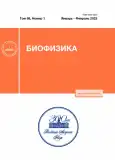Comparison of the dynamics of DNA damage in blood leukocytes and survival of mice after total body irradiation with Bragg peak carbon ions or x-rays
- Authors: Kuznetsova E.A1, Rozanova O.M1, Smirnova E.N1, Glukhov S.I1, Sirota T.V1, Belyakova T.A2, Sirota N.P1
-
Affiliations:
- Institute of Theoretical and Experimental Biophysics, Russian Academy of Sciences
- Physical-Technical Center of Lebedev Physical Institute, Russian Academy of Sciences
- Issue: Vol 68, No 1 (2023)
- Pages: 112-119
- Section: Articles
- URL: https://journals.rcsi.science/0006-3029/article/view/144410
- DOI: https://doi.org/10.31857/S000630292301012X
- EDN: https://elibrary.ru/OALBXD
- ID: 144410
Cite item
Full Text
Abstract
About the authors
E. A Kuznetsova
Institute of Theoretical and Experimental Biophysics, Russian Academy of Sciences
Email: kuzglu@rambler.ru
Pushchino, Moscow Region, Russia
O. M Rozanova
Institute of Theoretical and Experimental Biophysics, Russian Academy of SciencesPushchino, Moscow Region, Russia
E. N Smirnova
Institute of Theoretical and Experimental Biophysics, Russian Academy of SciencesPushchino, Moscow Region, Russia
S. I Glukhov
Institute of Theoretical and Experimental Biophysics, Russian Academy of SciencesPushchino, Moscow Region, Russia
T. V Sirota
Institute of Theoretical and Experimental Biophysics, Russian Academy of SciencesPushchino, Moscow Region, Russia
T. A Belyakova
Physical-Technical Center of Lebedev Physical Institute, Russian Academy of SciencesProtvino, Moscow Region, Russia
N. P Sirota
Institute of Theoretical and Experimental Biophysics, Russian Academy of SciencesPushchino, Moscow Region, Russia
References
- O. Mohamad, B. J. Sishc, J. Saha, et al., Cancers, 9, 66 (2017). doi: 10.3390/cancers9060066
- M. Moreno-Villanueva, M. Wong, T. Lu, et al., npj Microgravity, 3, 14 (2017). doi: 10.1038/s41526-017-0019-7
- I. Vavitsas and K. Kalachani, AIP Conf. Proc., 2075, 200018 (2019). doi: 10.1063/1.5099028
- S. Muralidharan, S. P. Sasi, M. A. Zuriaga, et al., Front. Oncol., 5, 231 (2015). doi: 10.3389/fonc.2015.00231
- E. I. Azzam, J. P. Jay-Gerin, and D. Pain, Cancer Lett., 327, 48 (2012). doi: 10.1016/j.canlet.2011.12.012
- A. R. Collins, A. A. Oscoz, G. Brunborg, et al., Mutagenesis, 23 (3), 143 (2008).
- E. A. Kuznetsova, N. P. Sirota, I. Y. Mitroshina, et al., Int. J. Radiat. Biol., 96 (10), 1245 (2020). doi: 10.1080/09553002.2020.1807640
- E. A. Kuznetsova., A. R. Dyukina, I. A. Chernigina, et al., Bull. Eksperim. Biologii i Meditsiny, 155 (6), 757 (2013). doi: 10.1007/s10517-013-2245-7
- N. K. Chemeris, A. B. Gapeyev, N. P. Sirota, et al., Mutat. Res., 558, 27 (2004).
- D. P. Lovell and T. Omori, Mutagenesis, 23 (3), 171 (2008).
- K. Datta, S. Suman, B. V. Kallakury, et al., PLoS One, 7 (8), e42224 (2012). doi: 10.1371/journal.pone.0042224
- А. И. Газиев, Радиационная биология. Радиоэкология, 39 (6), 630 (1999).
- M. H. Lankinen, L. M. Vilpo, and J. A. Vilpo, Mutat. Res., 352 (1-2), 31 (1996).
- J. M. Danforth, L. Provencher, and A. A. Goodarzi, Front. Cell Dev. Biol., 10, 910440 (2022). doi: 10.3389/fcell.2022.910440
- S. Kobashigawa, K. Suzuki, and S. Yamashita, Biochem. Biophys. Res. Commun., 414, 795 (2011).
- K. I. Matsumoto and M. Ueno, Y Shoji et al., Free Radic. Res., 55 (4), 450 (2021). doi: 10.1080/10715762.2021.1899171
- D. Averbeck and C. Rodriguez-Lafrasse, Int. J. Mol. Sci., 22 (20), 11047 (2021). doi: 10.3390/ijms222011047.
- R. B. Richardson and M. E. Harper, Oncotarget, 7 (16), 21469 (2016). doi: 10.18632/oncotarget.7412
- N. Chatterjee and G. C. Walker, Environ. Mol. Mutagen., 58 (5), 235 (2017). doi: 10.1002/em.22087
- http://www.andreevka.msk.ru/product.htm
- W. Tinganelli and M. Durante, Cancers (Basel), 12 (10), 3022 (2020). doi: 10.3390/cancers12103022
Supplementary files










